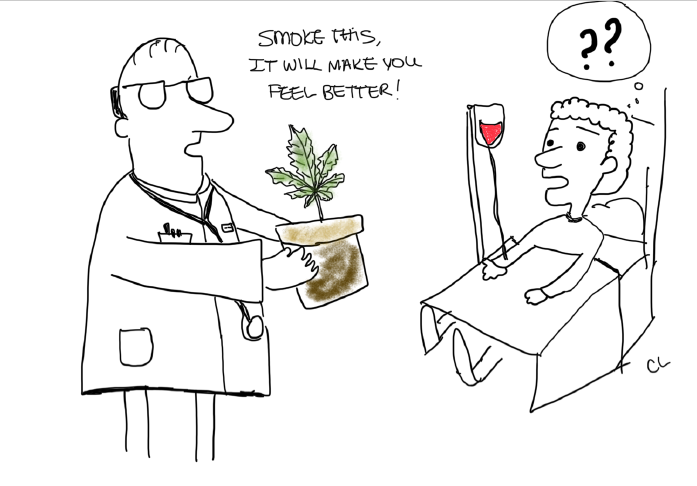
(author: #247249)
The author, Theodore Kapellos, is a postdoctoral researcher at the LIMES Institute of the University of Bonn. In this blog article, he shares his expertise on an interesting human physiological endogenous system that he studied during his PhD studies in the United Kingdom (https://www.path.ox.ac.uk/content/david-greaves). In contrast to its most popular recreational use, cannabis consumption may have significant medicinal implications in the fight against major chronic inflammatory diseases. This is due to the endocannabinoid system, which is activated by small lipophilic compounds with a very similar chemical structure to phytocannabinoids.
When we think of cannabis, the first thing that inevitably crosses our mind is the recreational use of plant-derived cannabis products. Surprisingly though, cannabis has a long medicinal history. In fact, the oldest reference that exists is 5,000 years old and described cannabis use as a remedy for malaria, constipation, rheumatic pains, child birth and as an analgesic (1). The 19th century saw cannabis being introduced to Europe as a therapeutic when the Irish scientist and doctor W.B. O’Shaughnessy tested it on humans and saw it possessed remarkable muscle-relaxant, anti-convulsant and analgesic effects (2). Even Queen Victoria’s personal physician himself described cannabis as “incomparable” for senile insomnia, temper disease, neuralgia and migraine among others!
The ambivalent view on Cannabis
Soon after, cannabis appeared in pharmacies across the British and the US market as a home remedy. However, and despite its original success, inconsistencies in cannabis potency from several herbal preparations, concerns about the consequences of its recreational use, the lack of alternative synthetic agonists and difficulties with oral administration resulted in a considerable decline in its use in the early 20th century. Eventually it was forbidden by law in several countries in Europe and around the world. Today, although considered illegal under US law, the medicinal use of cannabis is allowed in 33 states and the World Health Organisation has proposed that cannabis should be rescheduled within international law due to the growing evidence of its medicinal applications. Similarly, since November 2018 a few cannabis-related products are prescribed again in the UK (3).
In the last 30 years, anecdotal reports of the beneficial effects of cannabis use in inflammatory and neurological diseases led to a number of studies in academia as well as in the industrial sector. What is generally accepted is that cannabis use has the potential to turn into an efficient anti-inflammatory remedy in chemotherapy-induced nausea, multiple sclerosis-associated spasticity and muscle pain, AIDS-related nausea and opportunistic infections, glaucoma symptoms, epilepsy and asthma (2,4). These effects were proven to be derived from the endocannabinoid system which is defined by its receptors, endogenous ligands (cannabinoids) and biosynthesis, transport and degradation enzymes.

Cannabis-derived compounds with new properties lead to new options
For a historical perspective into the bloom of the endocannabinoid field, one does not have to go back many years ago. In the early 90s, two endogenous G protein-coupled receptors for cannabinoids were discovered; the first (CB1R) was expressed in the central nervous system and the second (CB2R) was detected in leukocytes, such as T cells, B cells, NK cells and macrophages (5–8). Due to its high prevalence in the brain and its involvement in the regulation of signal transmission, CB1R was considered as a potential target for neurodegenerative diseases, such as Parkinson’s, Alzheimer’s and schizophrenia and so the first cannabinoid-related therapeutics were licensed for clinical use as appetite stimulants and anti-emetics.
However, targeting CB1R, although successful, came together with a big challenge: The administration of high doses of cannabinoids led to off-target effects at irrelevant receptors causing unwanted side effects, such as psychotropism. In many of the early clinical trials, patients had to be excluded from the studies due to observed sedation effects, dizziness, panic, confused thinking, feeling of disturbance, disassociation, slurred speech, ataxia and blurred vision. It thus became obvious very quickly that we would need to design novel side effect-free agonists with comparable pharmacological properties to those of the licensed plant-derived cannabinoids.
In this light, CB2R-selective agonists became the forefront of the scientific efforts of the endocannabinoid field. CB2R activation was shown pre-clinically to modulate neuropathic pain and did not exhibit any psychotropic effects (9) and today there is a number of well-characterised CB2R-selective agonists at the pre-clinical stage with the ability to reverse neuropathic and chronic inflammatory pain devoid of any analgesic, sedative and cataleptic side effects. There is also a great potential for treatment of inflammatory diseases, such as rheumatoid arthritis, multiple sclerosis, atherosclerosis, sepsis, neuroinflammation, central nervous system injuries, brain ischemia and inflammatory bowel disease where CB2R agonists have been shown to attenuate the clinical outcome in animal models because of their direct effects on immune cells (9).
Another currently considered possibility is the use of CB1R and CB2R antagonists as novel therapeutics. For instance, Rimonabant, a CB1R antagonist, passed clinical trials and was licensed as an anti-obesity drug in 2006 and similarly CB2R antagonism is a promising target given the ability of CB2R-selective antagonists to mitigate leukocyte trafficking in vitro and in vivo. Finally, a strategy which has gained more attention lately is the indirect targeting of the endocannabinoid system via the biosynthetic enzymes of its endogenous ligands. This has been shown in animal models where the inhibition of degradation enzymes and cellular endocannabinoid uptake ameliorated pain, multiple sclerosis, Parkinson’s disease and tumour growth (10).
What the future will bring
Hopefully by now, I have demonstrated to you that the use of cannabis has a greater potential as remedy of difficult to tackle human diseases than as a recreational drug. There is, of course, still a long road to walk. All cannabis-related compounds are very lipophilic which makes them difficult to keep in an aqueous solution for delivery to patients. Moreover, some of them are quite unstable; they can degrade to their derivatives at different conversion rates limiting their half-life in vivo or their accessibility to the tissue of interest. However, with the current tools that we have in our disposal, it is very likely that soon our quiver against chronic inflammatory diseases will be richer with potent compounds ready to alleviate the burden of human patients. Here in Bonn, the ImmunoSensation member Prof. Andreas Zimmer (http://www.molpsychiatrie.uni-bonn.de/) is an absolute expert on the cannabinoid system – follow his research to keep up to date!
Author: Theodore Kapellos
Literature
- Robson P (2005). Human studies of cannabinoids and medicinal cannabis. Handb Exp Pharmacol719–56. Available at: http://www.ncbi.nlm.nih.gov/pubmed/16596794 [Accessed August 3, 2019]
- Robson P (2001). Therapeutic aspects of cannabis and cannabinoids. Br J Psychiatry 178:107–115. doi:10.1192/bjp.178.2.107
- Freeman TP et al. (2019). Medicinal use of cannabis based products and cannabinoids. BMJ l1141. doi:10.1136/bmj.l1141
- Grinspoon, L. and Bakalar JB (1993). Marihuana, The Forbidden Medicine. New Haven: Yale University Press. (1993).
- Carlisle SJ et al. (2002). Differential expression of the CB2 cannabinoid receptor by rodent macrophages and macrophage-like cells in relation to cell activation. Int Immunopharmacol 2:69–82. Available at: http://www.ncbi.nlm.nih.gov/pubmed/11789671 [Accessed January 27, 2018]
- Condie R et al. (1996). Cannabinoid inhibition of adenylate cyclase-mediated signal transduction and interleukin 2 (IL-2) expression in the murine T-cell line, EL4.IL-2. J Biol Chem 271:13175–83. doi: 10.1074/jbc.271.22.13175
- Galiègue S et al. (1995). Expression of central and peripheral cannabinoid receptors in human immune tissues and leukocyte subpopulations. Eur J Biochem 232:54–61. Available at: http://www.ncbi.nlm.nih.gov/pubmed/7556170 [Accessed January 27, 2018]
- Schatz AR et al. (1997). Cannabinoid receptors CB1 and CB2: a characterization of expression and adenylate cyclase modulation within the immune system. Toxicol Appl Pharmacol 142:278–87. doi: 10.1006/taap.1996.8034
- Turcotte C et al. (2016). The CB2 receptor and its role as a regulator of inflammation. Cell Mol Life Sci 73:4449–4470. doi: 10.1007/s00018-016-2300-4
- Pertwee RG (2005). The therapeutic potential of drugs that target cannabinoid receptors or modulate the tissue levels or actions of endocannabinoids. AAPS J 7:E625–E654. doi: 10.1208/aapsj070364
